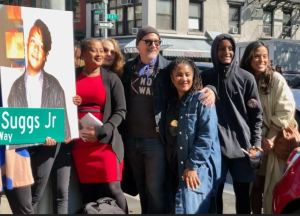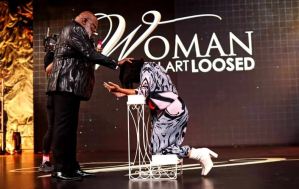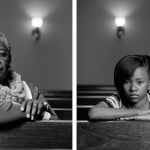By Dawn Suggs,
Word in Black
On a bright, crisp morning in October, a crowd of Donald Suggs Jr.’s friends, neighbors, and family from across the country gathered at the southwest corner of East 6th street and Avenue B in New York City’s East Village. In front of a verdant community garden, they witnessed the unveiling of the street sign “Donald Suggs Jr. Way,” 10 years and 10 days after Donald’s death.
As District 3 council member Carlina Rivera told those gathered: “To his friends and neighbors, he was the mayor of the East Village. He is remembered by many as a tireless activist for LGBTQ+ rights, an influential writer, and a caring friend.”
As I remarked during the street sign ceremony, “Donald was a trailblazer, the first person some of us knew to come out of the closet and say proudly he was a Black gay man.”
I loved Donald because he was my brother, but also because of how much he stood up for who he was and for his community. No doubt, if Donald was still here, he would be using his megaphone as a media activist — and his well-honed platform full-throttle as a journalist and national pundit — to protect, uplift, and empower LGBTQ+ folks of color as courageously and charismatically as he did when he walked the streets of New York.
The recent uptick in anti-LGBTQ rhetoric and laws fans the flames of intolerance and hatred against LGBTQ+ people and fuels the fire of those who wish to harm them, as so tragically born out in the recent mass shooting at Club Q in Colorado Springs, Colorado, which left five people dead and many more injured.
This violence, along with the crisis of Black trans people murdered, Black students being bullied, and “Don’t Say Gay” bills in schools, makes it even more crucial that we honor Black gay activists like Donald who have been through the fire and fought for justice — and that we know their stories and pick up the torch they carried.
Today, the block on East 6th street between Avenues A and B in “Alphabet City” is almost unrecognizable since the days Donald lived there, except for the gardens, the barbershop, and the bear statue that resides in front of Josie’s bar.

Ten years ago, one might run into half a dozen neighbors who had lived on 6th street since 1969; and all would agree that the neighborhood changed for the better in 1970 when a methadone clinic opened up close by. They would tell you about all the buildings that were set on fire in the neighborhood, allegedly gutted by property owners, and they remember when “The Godfather II” was filmed at Josie’s Bar (Joe’s at the time) and at the stoop across the street. Today, enclosed makeshift structures for outdoor dining, a New York mainstay of the pandemic, line and obfuscate the view of one side of the street while a row of blue rental bikes dominates much of the other.
Donald Marthell Suggs Jr. was born in Dover, Delaware, on Friday, March 13, 1961, the first child of Betty Ann Bateman Suggs, a teacher from Indianapolis, and Donald Marthell Suggs, an oral surgeon from E. Chicago, Ind. Shortly after our dad’s stint in the Air Force — when Donald was still an infant — the young family moved to St. Louis, Mo. where Dina and I were born.
In St. Louis, our family became active in the local arts scene and civil rights. Donald was a high-achieving student who ordered his first pair of leather pants from a catalog, became interested in experimental film, and taught himself how to make Super 8 films as a teenager. He nourished his love of the French language and culture in Rennes, France, where he spent his last year in high school.
Donald left the Midwest to attend Yale University in 1979. “His leadership helped usher in numerous “firsts” at Yale, including the 1982 Gay Lesbian Awareness Days, the inclusion of LGBT delegates at Yale freshman orientation weekend, and a ground-breaking series of gay-straight raps at which many straight students met out gay people for the first time. Donald also is remembered with immense gratitude by the many Yalies whom he inspired and mentored during their personal journeys out of the closet,” wrote the Yale Alumni Magazine after his death.
Dina remembers our brother as “always challenging norms, always percolating, and so creative. He was the best present wrapper and handicrafter… I cherish the [exquisite] dolls and teddy bears that he made for me. They remind me of his playfulness.”
Donald yearned to live in New York. In some respects, the St. Louis world Donald grew up in was like a village, an American village, post-segregation — largely a community of Black professionals and liberal Whites whom our parents bonded and socialized with.
As a gay youth in the late ‘70s and ‘80s, before one was of drinking age, there weren’t a lot of outlets for expressing oneself in St. Louis. Donald always credited flamboyant gay people, drag queens, and trans folk, in particular, for paving the way for everyone else under the LGBTQ flag. He emphasized that they had to take the most heat.
The Village in Manhattan, where LGBTQ folks stood up for themselves at Stonewall, was a place Donald dreamed of. It was a place where he imagined he could be himself completely.
He always attributed his understanding of what constituted “good home training” — being respectful of elders, women, children, and those with different abilities to being raised in St. Louis, but he couldn’t wait to escape some of his Midwestern confines.
He loved that his East Village neighborhood was full of many people like himself whose hunger for acceptance and creative expression of their authentic selves led them there. One of his favorite pastimes was strolling down the block, striking up conversations with his neighbors, new and old, and nurturing a sense of community.
Former companion Cass recollected, “I can’t count how many times we were walking around the Village, and someone would just come up to him, really happy to see him. And they were often thanking him for something he’d already done for them or at least helped them to achieve. He had the capacity to welcome people into his life in such an open, genuine way and make people feel like family.”
Conversely, Donald was critical of folks that “misbehaved” in the neighborhood, as he put it, and was protective of his neighbors. He would quickly check or situate with precise words an outsider, perhaps a frat boy, who behaved disrespectfully in the neighborhood, but if they came peacefully, so did he.
A pioneer in LGBTQ+ media activism
“Donald pioneered media activism by working with LGBTQ youth to produce videos on preventing the spread of HIV. Really broadening people’s understanding of what that meant, and how to live with each other in dignity and respect,” Council Member Rivera said when she recently opened the street naming program.
Donald also wrote extensively as a freelance journalist for publications ranging from The New York Times to The Advocate. He appeared regularly on The Ricki Lake show as a commentator on topics from women who fall in love with gay men to modern White backlash.
In 1991, Donald founded People Using Media to do Prevention, or the PUMP project. PUMP taught young people from neighborhoods devastated by HIV how to produce HIV prevention videos, which they then brought back to their own communities to teach their peers how to protect themselves from HIV/AIDS.
In 2007, PUMP alums joined with Better World Advertising and Salt and Pepper Media to co-produce a television prevention education ad campaign by and for Harlemites, which ran on MTV, VH1, BET, NY1, and Logo.
“His work to bring healthcare into Black and Latino LGBTQ communities unequivocally saved people’s lives with HIV and AIDS,” Rivera said. She added, “I know many of us have experienced that loss directly, and it is still something we live with.”

The street sign effort
Rivera, the council member of District 3, introduced the bill to the New York City Council to have the southwest corner of 6th Street at Avenue B, co-named Donald Suggs Jr. Way. At every stage, after presentations to the Transportation Committee, Manhattan Board 3, and finally to the New York City Council, made up of all districts throughout Manhattan, the bill was passed unanimously.
The years-long effort to rename 6th Street between A & B began shortly after Donald died, unexpectedly, of heart disease on Oct. 5, 2012. Around the time that a memorial service was being planned for him, a group of friends and family, led initially by Jennifer Callahan, a friend of Donald’s and former Village resident, began to organize a tribute to him, co-naming the block of 6th Street, his stomping grounds and where he resided, “Donald Suggs Jr. Way.”
The Donald Suggs Jr. Street Naming Project formed and eventually partnered with fiscal sponsor Grassroots Leadership five years after Donald’s death. A person proposed for the co-naming has to be deceased several years prior to the initiation of the co-naming and must have made a significant contribution to the community over the long term recognized by a large swath of its residents, according to district guidelines.
Grassroots Leadership helped raise funds to hire a project coordinator, who worked with me to identify and collect the signatures of over 75 percent of the almost 600 businesses and people who lived on the block — no small feat in bustling New York City.
Addresses and names had to be verified, and many residents proved difficult to find and follow up with. Gabriella Sonam, who lived in the East Village and knew Donald personally, dug in her heels as project coordinator and collected the final signatures, and helped submit the petition to the Transportation Committee of Manhattan Board 3. She also worked closely with the Board and Council Member Carlina Rivera’s office to make sure the legislation was voted on during the height of the pandemic and the street sign would be installed this fall while the weather permitted.
Bob Libal, the director of Grassroots Leadership at the time, spoke of the influence that Donald, a media consultant of the organization, had as a cultural critic who trained and mentored young media producers, and broadened the discussion of intersectionality, advocating for civil rights, healthcare, and equity for LGBTQ+ people of color.
Donald’s efforts reached beyond New York to Iowa, Arizona, Texas, and eventually, Central, South America, and the Caribbean while he worked within African and Latinx immigrant communities in New York.
“Donald’s impact was far-reaching and felt by the next generation of media-makers and organizers. After Donald passed, activists from the LGBT and Black Lives Matter movement reached out about his inspirational impact on their work,” Libal said.
Dr. Stephanie Factor, an infectious disease specialist, commented shortly after his death that Donald’s HIV/AIDS prevention work was often cited for changing the landscape of American HIV messaging campaigns.
He pioneered new ways to reach people of color who were disproportionately impacted by the transmission of HIV from sexual partners, primarily men, who “on the down-low,” had unprotected sex with other men but didn’t consider themselves gay, and didn’t relate to messaging targeted at gay White men.
Speaking out against homophobia in music
Early in his career, Donald produced an investigative piece about New York youth who were out or recognizably LGBTQ and had to leave school or go to an alternative high school because of the abuse and the threats of violence they faced.
He later became known and was attacked by some for daring to speak out and write about homophobia within the music industry and hip hop, in particular, most notably speaking out against Buju Banton’s homophobic screed “Boom Bye Bye,” a rap that fantasizes about killing gay people and men referred to in Jamaican slang as “batty bwoy”:
“Boom bye bye
Inna batty bwoy head
Rude bwoy no promote no nasty man
Dem haffi dead”
Donald, who was working as a public relations director for GLAAD at the time the record was released and being played on radio stations throughout the U.S., gave the following response to the New York Times about Bantu’s homophobic statements and defense: “We think his statements are unfortunate… but this issue is about violence, and we felt that it was important for him to say that it’s not acceptable, which he did.”
Eventually, Mercury Records, Bantu’s new record label in 1992, agreed to make PSAs against hate speech due to the pressure put on by the public, and most pointedly, Donald through his work at GLAAD.
“Oh you make me feel mighty real
You make me feel mighty real
Make me feel – mighty real
Make me feel – mighty real
Make me feel – mighty real
Make me feel – mighty real”
-Sylvester
Groundbreaking support of the transgender community
At a Manhattan Community Board meeting in 2020, John Grauwiler, an 6th street neighbor, who came out to speak publicly in favor of the street co-naming, talked about meeting Donald in the early ‘90s — and how Donald was an ally and advocate for the transgender community at the time.

“I was a 27-year-old boy who was deeply immersed in queer culture. Many of my friends were transgender. Donald, at that time, was volunteering for a transgender organization on 29th and Eighth Avenue that uplifted transgender sex workers,” Grauwiler said.
“He invited me, shortly after meeting him, to the organization to meet and talk with people who were there, as well as others who were organizing and supporting, uplifting, and keeping trans workers safe,” Grauwiler said.
“I brought some of my friends with me, some who were trans, some who are not, and it was a truly powerful experience for all of us. My friends said that they felt — some of them, who at the time were sex workers — they didn’t realize that this existed. It was through Donald that friends of mine were able to sort of feel some empowerment and have a touchstone to a place that actually offered them support.”
Council Member Rivera had this to say about Donald’s career as a journalist who reported on the trans community: “As a writer for The Village Voice, he wrote the first major article about the largely Black and trans Harlem ballroom scene [“Venus Envy, The Harlem Balls Take on The World.”] It’s culturally such a significant part of New York City. And I’m just so glad that we can mention not just the ballroom scene, but of course, our trans community, it’s one of the most historically marginalized communities in history and we have so much work to do.”
It just so happens that at the time the street naming project passed the committee for Manhattan Board 3 and moved to Rivera’s chamber, Rivera was co-sponsoring a bill to repeal what is commonly known as the “Walking while trans” law.
This New York statute from the ‘70s was disproportionately used by police to harass and arrest trans women of color for the clothes they wore or the way they stood on the street; if arrested, they had to carry it on their record, restricting their ability to get jobs off the street. Donald would have been strongly supportive of the repeal, and it seems fitting that Rivera was the councilwoman who also presented the bill to co-name 6th Street in honor of Donald to the New York City Council. Fortunately, the ban was repealed in February 2021, hundreds of warrants dating back to 2012 were vacated, and even older warrants are expected to be dismissed.
Solidarity and alliance – perfect ways to love
“I feel like this street sign is going to remind all of us of who Donald was and help us remember that we can be like that too,” said Donald Suggs Jr. Street Naming Project Coordinator Gabriella Sonam. “You know, Donald was a wonderful example of how to be a neighbor, how to be a citizen of the block, of the city, of the world.”
And we can take our cues from Donald’s legacy. There’s even more to be done today in the U.S. — beyond the granting of same-sex marriage rights by the Supreme Court in 2015 — to legislate, enshrine the rights, and protect the very existence of LGBTQ+ people in this country, trans people of color in particular.
Extreme right-wing dogma and social media posts that attack LGBTQ+ people endanger lives, threaten health, healthcare, housing, education, and access to information for this already vulnerable population further stigmatized by anti-LGBTQ policies and legislation, such as the “Don’t Say Gay” bills from Miami to Missouri.
New York passed The Sexual Orientation Non-Discrimination Act (“SONDA”) in 2002, but Missouri has yet to pass The Missouri Nondiscrimination Act prohibiting discrimination based on gender and sexual identity and orientation, first introduced in 1998.
It is the hope of those who spoke about Donald and attended the unveiling ceremony of the Donald Suggs Jr. Way sign, that the recognition of Donald will inspire others, particularly young people, to continue the fight for human rights — especially for the rights of LGBTQ+ people of color, those most marginalized and mistreated — which Donald held so dear.
Donald’s gay son Dr. Luis Ramirez concluded his remarks at the unveiling by saying he is “happy to see that Donald keeps expanding like the universe… And now he’s gonna be here (referring to the sign). Ramirez added that “hopefully [we’re] going to be able to remember all the queer people that we can — immortalize the work that a gay Black man [did] in this community.”
Ramirez said Donald created solidarity, formed alliances, and demonstrated “a perfect way to love — for everybody. So Donald, we’re gonna love him forever.”
Help us Continue to tell OUR Story and join the AFRO family as a member –subscribers are now members! Join here!
The post The Pioneering Black LGBT Activist You Probably Don’t Know – But Should appeared first on AFRO American Newspapers .











